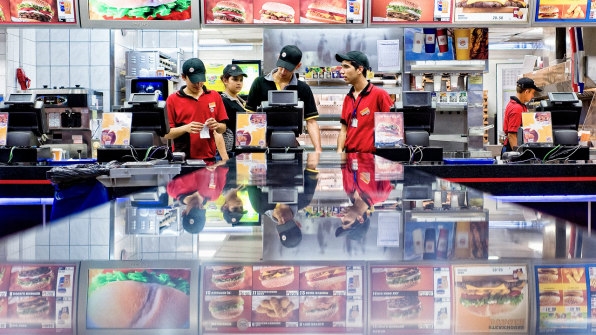Is Seattle’s Rising Minimum Wage Helping Or Hurting Low-Wage Workers?
As the minimum wage goes up in Seattle–with workers now required to make as much as $15 an hour, and all workers set to make that much by 2021–the city has become a bellwether for other communities that are looking to raise their minimum wage or have one already scheduled. Instead of arguing about economic theory, we can finally look at real data. One recent report found that the changes haven’t led to a loss in jobs in food service, a key industry for low-wage jobs. But another new study says that the effects are more complicated: While the overall number of restaurant jobs might not have changed much, the researchers believe that low-wage workers in the city are working fewer hours. Even though those workers might be earning more per hour, the study finds, they’re losing an average of $125 a month.
The study, published by the National Bureau of Economic Research, is still a work in process and has not yet been peer-reviewed (it has also already attracted significant criticism). The researchers, economists from the University of Washington, used unique data that includes both hourly wages and the number of hours worked for individuals, something that past studies haven’t; only four states, including Washington, collect such detailed data.
“Because other studies didn’t have this rich data, they would pick a proxy for low-wage workers–the standard one has been the restaurant industry, because it does employ a lot of low-wage workers,” says Robert Plotnick, a public policy professor at the University of Washington and one of the authors. “But when you look at the restaurant industry in total, you’re also including a lot of medium- and high-wage workers . . . you can’t quite answer that question as well as we can.”

At the time voters in Seattle approved the minimum wage increase, in 2014, the minimum wage was $9.96. It increased to $11 by April 2015, $13 per hour by January 2016, and $15 an hour, for some workers at large companies, by January 2017. The University of Washington study looks at the effects of the raise to $13.
Compared to a scenario where Seattle didn’t raise the minimum wage–a model the researchers call “synthetic Seattle”–the study estimates that workers earning less than $19 an hour worked 9.4% fewer hours after the wage rose to $13 per hour. The income lost because of the reduction in hours outweighs the gains from an increase in wages.
Critics say that the study has flaws. For one, it didn’t include the employees from large businesses that have locations both inside and outside of Seattle, McDonald’s, for example. In a letter to the mayor of Seattle, Michael Reich, a professor of economics at the University of California-Berkeley and one of the authors of the other recent report (also not peer-reviewed) that said food service jobs had not been lost in Seattle, said that excluding multisite employers excludes 48% of Seattle’s low-paid workforce. As well, workers who left a single-site employer for a larger company are counted as losing a job, while their new wages don’t factor into the analysis.
The University of Washington’s researchers’ model of what would have happened in Seattle without the wage increase might also be flawed. It’s tricky to isolate, as Seattle’s economy has also grown rapidly during the same period, and an increase in higher-wage jobs and a decrease in low-wage jobs could also be the result of a hot economy. To build the model, the researchers compared the city to other communities that didn’t increase their minimum wage, but they were limited to Washington, where other hourly wage data was available. Reich argues that the economies used to create the model aren’t anything like Seattle, where the booming tech sector is creating economic growth totally separate from the rest of the state.
Still, the researchers used an algorithm to choose the places that had low-wage jobs most similar to Seattle and saw a clear divergence at the point when the minimum wage in Seattle went up to $13 an hour.
“Seattle’s economy’s been doing very well for a number of years, and there’s nothing magical about the first quarter of 2016,” says Plotnick. “It’s been booming really since the recession ended. But the fact that we see this impact right when the wage goes up is strong evidence. Could something else have driven it? Perhaps. But it was our best judgment that we were picking up a real effect and not something that was a coincidence.”
Like the Berkeley researchers, the University of Washington researchers found that the number of food service jobs didn’t sharply drop because of the raise in wages. But they did see a drop in hours. “When we shift the focus using our better data we do find negative employment effects about the same as we found for the overall city,” Plotnick says.
The drop in hours worked suggests that restaurants might be hiring more experienced, efficient workers, potentially making it harder for others to get an entry-level position. The researchers hope to do more research on how different demographics are affected–whether heads of households finding it hard to get enough hours or low-wage work, for example, or whether the impacts are higher on teenagers or others who would add a second or third income to a household.
“To really make a policy judgment or a final judgment you really like to know who those workers are . . . We don’t have that,” he says. “We plan to look at that in the future. If you’re making policy, the distribution matters, along with the average. What we’re presenting is average effects.”
He also makes it clear that the findings of this study don’t necessarily apply to other cities, and not to states. “If a state passes the minimum wage, it’s much harder to shift your workers out of state than it is to move them out of the city,” Plotnick says. Other cities can have very different economic structures, and different geographic proximity to nearby cities where companies or workers could move.
“We know people would like to sort of take the lessons wholesale elsewhere,” he says. “We think that’s beyond what our data can tell us. We want to be very careful about that. You shouldn’t generalize it.”
A new study finds the city’s rising minimum wage means low-wage workers are getting paid more but working fewer hours. Is it right?
As the minimum wage goes up in Seattle–with with workers now required to make as much as 15 an hour, and all workers set to make that much by 2021–the city has become a bellwether for other communities that are looking to raise their minimum wage or have one already scheduled. Instead of arguing about economic theory, we can finally look at real data. One recent report found that the changes haven’t led to a loss in jobs in food service, a key industry for low-wage jobs. But another new study says that the effects are more complicated: While the overall number of restaurant jobs might not have changed much, the researchers believe that low-wage workers in the city are working fewer hours. Even though those workers might be earning more per hour, the study finds, they’re losing an average of $ 125 a month.
Fast Company , Read Full Story
(44)






